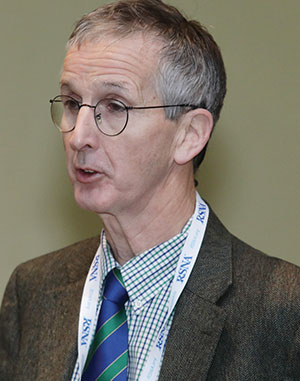Advanced Imaging Aids the Quest to Authenticate or Refute the Value of Ancient Artifacts

When the Walters Art Museum in Baltimore asked radiologist Barry Daly, MD, to help determine the authenticity of a rare vase from the Qing Dynasty, the staff knew there was a chance he would uncover something they might rather not know.
After all, faux and forged artifacts have long been a major challenge in the art world, said Dr. Daly, who spoke on the topic at RSNA 2018. But the museum staff, who had previously worked with Dr. Daly, a radiology professor at the University of Maryland, Baltimore, on imaging ancient mummies was prepared to take the risk in pursuit of the truth.
Using 3D CT to non-invasively analyze the structure — which was highly unique for its series of interlocking parts — Dr. Daly detected damage at the base of the vase which he later discovered was a highly sophisticated hidden repair. Passed through the hands of numerous
curators over the years, the repair had never been detected.
Dr. Daly believes the repair was made during the firing and before the painting of the vase, which was likely presented to the royal family as being in perfect condition. This was incredibly risky at the time of the Qing Dynasty, which ruled China from 1644 to 1912.
“It was not a good idea to double-cross the Emperor,” Dr. Daly said. “If he found out, heads would have rolled.”
Old Paintings are New Again
In the modern day, fakes and forgeries do not carry the same type of risk, but they do present a problem to museums around the world which are increasingly turning to radiologists in their quest to authenticate ancient treasures —often a formidable task.
“Some of the fakes and repairs are so well done that it is almost an art form in itself,” Dr. Daly said.
Although X-ray is a common tool at many museums and conservation labs, CT is able to provide detailed views of the inside and outside of art objects. Along with structural details, CT can provide historical and chronological context and provide information useful in the restoration, preservation and valuation of artifacts.
And as imaging advances, so do its capabilities in the art world. For example, the technology macro X-ray fluorescence scanning has revealed astonishing surprises under already treasured artwork.
In 2011, curators at the Rijksmuseum in Amsterdam used macro X-ray fluorescence scanning on the 1823 Portrait of the Spanish judge Don Ramon Satue, by Francisco Goya, and revealed another, unfinished portrait underneath the masterpiece.
As it turns out, the technology, in which fluorescent X-rays map the picture’s pigments to create a color image, revealed a painting of Joseph Bonaparte, Napolean’s brother, painted about a decade before the Satue portrait.
While canvas was expensive and often reused by artists, Dr. Daly said there may have been another reason Goya painted over the Bonaparte portrait. Keeping it could have been dangerous.
“Why did he wait 10 years to use the canvas again?” Dr. Daly asked. “Joseph had to flee, and Goya might have thought that, being a Bonaparte, Joseph would return and demand he finish the painting, so he covered it up.”
And 3D CT has opened up a whole new world for authenticators of ancient artwork.
Dr. Daly presented the case of a Gothic reliquary believed to contain the bones of 7th century Christian Saint Amandus. A 3D CT study provided detailed images of the wood under the gilded copper casing which dated the reliquary at 1218 AD. The new information elicited different reactions from staff at the Walters Art Museum.
“One person at the museum was disappointed it wasn’t older,” Dr. Daly said. “The chief conservator at the museum, with 40 years of experience, said, ‘I’m just grateful it’s not a 19th century knockoff.’”
Reassessing Value
In the consumer market, fakes, hidden repairs and other forgeries revealed through imaging could drastically reduce the value of a piece of art, Dr. Daly said. But museums, which don’t sell the pieces, aren’t as concerned with the monetary value of their treasures.
In fact, new information or a fascinating story, such as with the vase from the Qing Dynasty, often increases interest and makes the piece more prized by museums and their patrons.
“The Qing Dynasty vase is still on display at the museum,” Dr. Daly said. “Conservators and curators are more interested in the science and facts, and it is rare that they would want to sell. The intrigue associated with a history is very valuable in itself. So the museum would rather know the truth. They aren’t in it for the money.”


